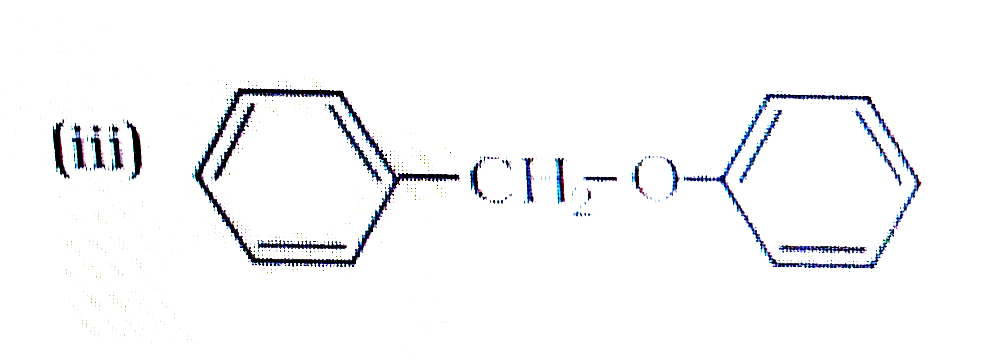On the basis of hydribidsation predict the shape of the following molecules
(i)
(ii)
To predict the shape of the given molecules based on hybridization, we will follow these steps:
Step 1: Determine the Hybridization of CH₃F
1. Identify the central atom: In CH₃F, the central atom is carbon (C).
2. Count the valence electrons: Carbon has 4 valence electrons.
3. Count the attached atoms: There are 3 hydrogen atoms and 1 fluorine atom attached to carbon, which gives us a total of 4 monovalent atoms.
4. Use the hybridization formula:
Hybridization=12(Number of valence electrons on central atom+Number of monovalent atoms attached−Charge on cation+Charge on anion)
Since there are no charges, the formula simplifies to:
Hybridization=12(4+4)=82=4
5. Determine the hybridization type: A steric number of 4 corresponds to sp³ hybridization.
Step 2: Predict the Shape of CH₃F
1. Shape based on hybridization: The sp³ hybridization indicates a tetrahedral arrangement of electron pairs.
2. Conclusion: Therefore, the shape of CH₃F is tetrahedral.
Step 3: Determine the Hybridization of CH₂=O
1. Identify the central atom: In CH₂=O, the central atom is again carbon (C).
2. Count the valence electrons: Carbon has 4 valence electrons.
3. Count the attached atoms: There are 2 hydrogen atoms and 1 oxygen atom attached to carbon. Oxygen is divalent, so it counts as 2.
4. Use the hybridization formula:
Hybridization=12(Number of valence electrons on central atom+Number of monovalent atoms attached−Charge on cation+Charge on anion)
Again, there are no charges, so:
Hybridization=12(4+2)=62=3
5. Determine the hybridization type: A steric number of 3 corresponds to sp² hybridization.
Step 4: Predict the Shape of CH₂=O
1. Shape based on hybridization: The sp² hybridization indicates a trigonal planar arrangement of electron pairs.
2. Conclusion: Therefore, the shape of CH₂=O is trigonal planar.
Final Summary:
- The shape of CH₃F is tetrahedral.
- The shape of CH₂=O is trigonal planar.
2. Count the valence electrons: Carbon has 4 valence electrons.
3. Count the attached atoms: There are 3 hydrogen atoms and 1 fluorine atom attached to carbon, which gives us a total of 4 monovalent atoms.
4. Use the hybridization formula:
Hybridization=12(Number of valence electrons on central atom+Number of monovalent atoms attached−Charge on cation+Charge on anion)
Since there are no charges, the formula simplifies to:
Hybridization=12(4+4)=82=4
5. Determine the hybridization type: A steric number of 4 corresponds to sp³ hybridization.
2. Conclusion: Therefore, the shape of CH₃F is tetrahedral.
2. Count the valence electrons: Carbon has 4 valence electrons.
3. Count the attached atoms: There are 2 hydrogen atoms and 1 oxygen atom attached to carbon. Oxygen is divalent, so it counts as 2.
4. Use the hybridization formula:
Hybridization=12(Number of valence electrons on central atom+Number of monovalent atoms attached−Charge on cation+Charge on anion)
Again, there are no charges, so:
Hybridization=12(4+2)=62=3
5. Determine the hybridization type: A steric number of 3 corresponds to sp² hybridization.
2. Conclusion: Therefore, the shape of CH₂=O is trigonal planar.
- The shape of CH₃F is tetrahedral.
- The shape of CH₂=O is trigonal planar.
Topper's Solved these Questions
- ORGANIC CHEMISTRY: SOME BASIC PRINCIPLE AND TECHNIQUESBook:AAKASH INSTITUTE ENGLISHChapter:ORGANIC CHEMISTRY: SOME BASIC PRINCIPLE AND TECHNIQUESExercise:SECTION-J AAKASH CHALLENGERS QUESTIONS
Explore 10 Videos
- ORGANIC CHEMISTRY : SOME BASIC PRINCIPLES AND TECHNIQUES Book:AAKASH INSTITUTE ENGLISHChapter:ORGANIC CHEMISTRY : SOME BASIC PRINCIPLES AND TECHNIQUES Exercise:Assignment(Section-D)(Assertion - Reason Type Questions)
Explore 15 Videos
- POLYMERSBook:AAKASH INSTITUTE ENGLISHChapter:POLYMERSExercise:ASSIGNMENT (SECTION-D)
Explore 13 Videos
Similar Questions
Knowledge Check
What are the hybridization and shapes of the following molecules?
(i) CH3F
(ii) HC≡NA(i) sp2, trigonal planar, (ii) sp3, tetrahedralB(i) sp3, tetrahedral, (ii) sp, linearC(i) sp, linear, (ii) sp2, trigonal planarD(i) sp2, trigonal planar, (ii) sp2, trigonal planar
On the basis of VSEPR theory, predict the shapes of the following molecules :
PH3
View SolutionOn the basis of VSEPR theory, predict the shapes of the following molecules :
HgBr2
View SolutionOn the basis of VSEPR theory, predict the shapes of the following molecules/ions?
a. AsF5 , b. SbCl3 , c. F2O , d.H3O⊕
e. HC≡CH , f. ⊕NH4 , g. o−NH2 , h. GeF4
View SolutionOn the basis of the structures, predict which of the following molecules are polar?
H2O,CO2,BeCl2,PH3,CH4,CCl4,SO2.
View SolutionGive the IUPAC name of the following compounds:
(i) CH3COCH(CH3)2, (ii) CH3CH(OH)CH2CHO ,
View SolutionWhich hybrid orbitals are used by carbon atoms in the following molecules?
(a)CH3−CH3,(b)CH3−CH=CH2,(c)CH3−CH2OH,
(d)CH3−CHO,(e)CH3−CHO (f)CH3COOH
View SolutionGive the major products that are formed by heating each of the following ethers with HI.
(i) CH3−CH2−CH3| CH−CH2−O−CH2−CH3
(ii) CH3−CH2−CH2−O−CH3∣C∣CH3−CH2−CH3
(iii)
View Solution